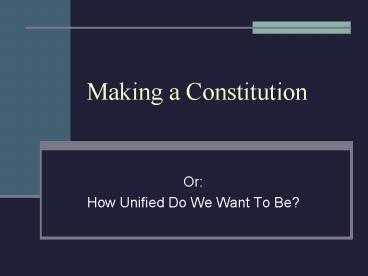Making a Constitution PowerPoint PPT Presentation
1 / 12
Title: Making a Constitution
1
Making a Constitution
- Or
- How Unified Do We Want To Be?
2
Deciding to Unite
- Encouraging Unity
- English language and Culture
- Single geographic unit
- States had no tradition of war with each other
- Cooperated to win independence
- Against Unity
- Loyalty to individual state
- Large area, poor roads and transportation
- States traded more with Europe and Caribbean than
each other - No longer had a common enemy
3
Articles of Confederation
- Framework of new government
- Adopted in 1781
- Created a league of 13 independent states
- EXTREMELY WEAK
4
Weaknesses of Articles of Confederation
- Congress could hardly make laws
- Needed 9/13 to pass
- Rarely were more than 10 delegates present
- No chief executive, all law enforcement left to
state - No central courts to handle issues between states
- Amendment to Articles required unanimous vote
- Congress could not levy taxes, only ask states
- 75 of these requests ignores
- Congress could issue money, but so could every
state
5
More Weaknesses
- Congress could not raise an army, only request
states to send recruits - This weakness shown in Shays Rebellion
- Daniel Shays led debtors in armed rebellion in
Massachusetts seeking to end prison sentences for
debt - Seized courthouses and tried to take US armory at
Springfield - US government could do nothing, finally rebellion
put down by Massachusetts militia - Congress had no power to control interstate or
foreign commerce - Each state had own taxes and tariffs
- Government had little respect abroad
- Britain blatantly violated the Treaty of Paris by
putting forts in the Northwest Territory
6
Western Territories
- Maryland refused to adopt Articles until states
with Western territories gave them to government - Government gained the Northwestern Territory
- Northwest Ordinance of 1787
- Should be divided into no less than 3 and no more
than 5 states - Eventually became Ohio, Indiana, Michigan,
Illinois, and Wisconsin - When territory got 5000 male adults, could elect
own legislature - 60,000 inhabitants could have a constitution and
statehood - Slavery forbidden
- Significance
- Served as policy for sale of western lands
- Model for democratic treatment of territories
that contrasted sharply with Englands dealings
with the 13 colonies - Set precedent for admission of new states
7
(No Transcript)
8
Constitutional Convention 1787
- Delegates were mainly lawyers, landowners,
bankers, merchants - Leaders
- George Washington presided over Convention
- James Madison took notes, father of the
Constitution
9
A Bundle of Compromises
- Representation
- Virginia Plan (Big States)
- Representation in national legislature be based
on state population - New Jersey Plan (Little States)
- Each states should have equal representation
- Great Compromise
- Bicameral Legislature
- Senate Two representatives from each state
- House of Representatives representation based on
population
10
More Compromises
- Slavery
- Southern states wanted slaves to be counted as
part of population for representation but not
taxes - 3/5 Compromise
- Five slaves counted as three people for purposed
of representation and taxation - Tariffs
- South afraid of Congress levying taxes on exports
- Compromise Congress could tax imports, but not
exports - Presidency
- Feared too much power, too long a term, etc
- Compromise
- 4 year term
- Electoral college
11
Adoption of Constitution
- Needed 9/13 states to adopt
- Debate
- Federalists supporters of Constitution
- Wealthy
- Nation more important than state
- Said Constitution would provide a stable
Government, law and order, economic prosperity - Anti-Federalists Opponents of Constitution
- City-workers, farmers
- Said Constitution served rich, threatened states,
people unprotected against powerful central
government - This made Federalist pledge to add a Bill of
Rights
The Federalists are shown on the Right,
anti-federalists on the left, they are each
pulling a broken down wagon in opposite directions
12
Success of Federalists
- Well-organized, could spend much money on
achieving ratification - Anti-Federalists supported weak Articles
- Federalists were supported by wealthy, who could
vote - Alexander Hamilton, John Jay, and James Madison
were leaders - Wrote series of articles called The Federalist
Papers that were published in New York newspapers
and widely read - Also supported by Benjamin Franklin and George
Washington both highly respected

